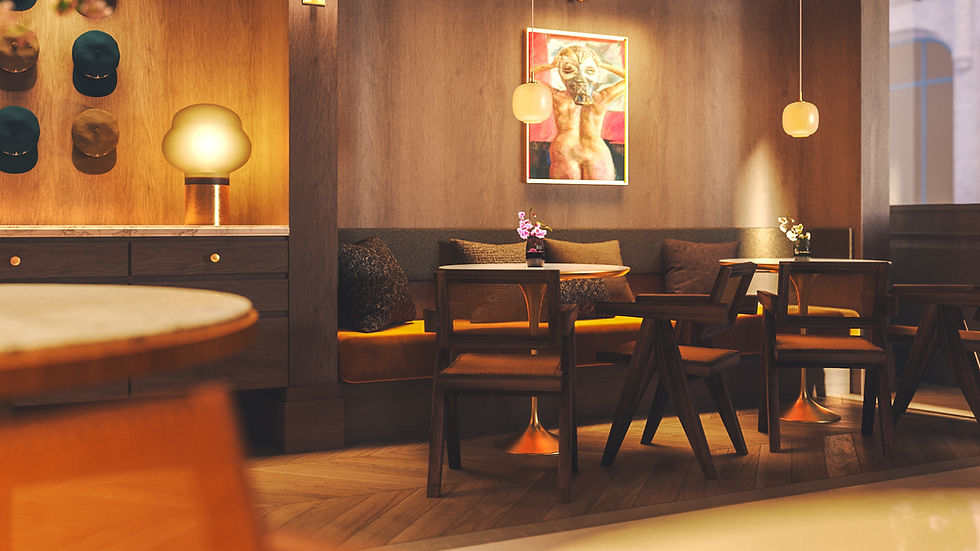How to Sell Properties in 2025
- Luan Nogueira

- Jun 25
- 4 min read

The Art of Creating Desire Before the First Brick Is Laid
Somewhere between the shimmering towers of Canary Wharf and the leafy lanes of West London, a developer is staring at pre-sales numbers that won’t budge. The location is strong. The floorplans generous.
The finishes impeccable. And yet — interest is tepid, viewings sparse, the spark missing.Thousands of miles away, in São Paulo, a high-rise marketing team wrestles with a different kind of silence. Their digital ads are being seen — the analytics say so — but buyers scroll past. No emotion, no connection. Just another project in a city skyline already crowded with promise.
Meanwhile, in Toronto’s suburbs, a new build sells out its first phase in weeks — long before construction begins. Its secret? A campaign not of specs, but of dreams. A narrative of families gathering on sun-drenched terraces, children cycling along tree-lined paths, golden light pouring through open-plan kitchens at dusk.
The Buyer Who Never Walks Through the Door
This is the paradox of 2025: buyers are everywhere — and nowhere. In Knight Frank’s 2024 Global Buyer Survey,➡ 65% of premium property buyers now spend over 90 days researching online before ever contacting a sales team.➡ More than 50% of high-net-worth individuals bought outside their home country in 2024 (Savills).
From a London apartment marketed to a tech entrepreneur in Singapore, to a Brazilian investor eyeing Toronto as a safe harbour, the audience is global. And what they want is no longer a list of features — it’s feeling.
They don’t tour showrooms first. They tour the dream. And if that dream fails to move them? They scroll on.
In a world where the first encounter is digital, desire has to start long before anyone steps onto a sales floor.
The Old Tools, Dull in a New Light
There was a time when a crisp brochure, a few CGI images, and a well-dressed showroom modelled with artificial fruit would suffice. No longer.
Today, JLL’s 2024 Global Marketing Study reports: - Developments using static visuals as their primary marketing tool took 22% longer to achieve pre-sales targets. - Listings that failed to engage emotionally saw inquiry rates 37% lower than those using cinematic, immersive storytelling (NAR, 2024).
And in markets as distinct as London, São Paulo, and Vancouver, developers clinging to old tools are discovering the cost of invisibility.
Selling the Vision, Not the Volume
Consider two projects launched last autumn in Greater London.
The first, a meticulously designed mid-rise in Battersea, led with floorplans, a website heavy on text, and a single generic 3D render. It struggled to capture even 30% of its pre-sale target by year-end.
The second, a townhouse collection in Richmond, told a different story. Its marketing campaign opened with a cinematic film — golden-hour drone shots of the river, interiors staged like a Ralph Lauren shoot, ambient soundscapes of birdsong and distant laughter. Interactive tours let buyers step inside spaces not yet built. The result? 75% sold before foundation work began.
Canada: Where Data Meets Emotion
In Canada’s competitive urban fringe, the battle for buyers is no less fierce. Toronto developers report that buyers — many from China, India, and the Middle East — now demand more than floor area and parking spots. They want proof of energy efficiency, of walkability, of community integration.
Canada Mortgage and Housing Corporation (CMHC) noted in 2024 that 61% of new home buyers rated sustainability features as highly influential in their decision, and nearly 70% said they were swayed by the quality of pre-sale digital presentations.
Gone are the days when a development’s name and postcode were enough. In their place? A blend of data and dream — smart home demos woven into AR tours, daylight studies presented through atmospheric renders, entire campaigns designed to make a buyer feel at home before they’ve even left theirs.
Brazil: Selling to a Market Saturated with Promises
São Paulo — a city of more than 12 million souls — has long been a developer’s paradise and nightmare in equal measure. The skyline bristles with cranes; the market brims with competition.
Yet many projects falter because they lean too heavily on what used to work: location, pricing, and standard images. The buyer in Brazil’s prime cities has grown immune to sameness.
Secovi-SP’s 2024 survey found that developments offering immersive, cinematic pre-sale campaigns reached 35% higher early commitment rates compared to those using traditional sales methods.
What sells? Campaigns that show not just where you’ll live, but how you’ll live. A São Paulo penthouse bathed in soft dusk light, its balcony alive with city sounds; a family apartment where dinner scenes play out against the backdrop of the skyline; a villa where the promise of calm is felt in every frame.
The Studios Crafting the Dream
Behind these campaigns — the ones that work — are studios who understand that selling property in 2025 is less about specs and more about seduction.
Xarp Studio has quietly been part of that shift. Our work — from cinematic 3D films to AR showrooms to hyper-real lifestyle imagery — isn’t about decoration. It’s about emotion. About creating that moment when a buyer looks at a screen and thinks: this is my life.
We’ve helped developments across London, São Paulo, Toronto, and beyond tell stories compelling enough to close the distance between pixel and purchase.
Because in the end, what sells a home isn’t the plan. It’s the possibility.
The New Front Door
If 2025 has taught the industry anything, it’s this: the front door is no longer made of glass and steel. It’s made of pixels, light, and narrative.
And if your project’s story doesn’t invite the buyer inside? Someone else’s will.




Comments